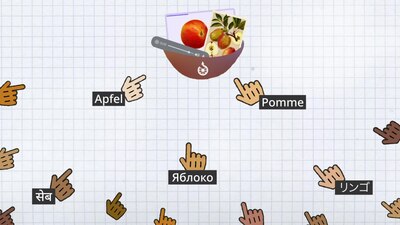Commons:Structured data
About Structured Data on Commons
Structured data on Commons is multilingual information about a media file that can be understood by humans, with enough consistency that it can also be uniformly processed by machines. Files on Wikimedia Commons can be described with multilingual concepts from Wikidata, Wikimedia's knowledge base.
The software development for this project in 2017-2019 was funded by the Alfred P. Sloan Foundation.
What Structured Data on Commons does
Structured data on Commons is useful to both content creators and content users and improves access, searchability, exploration and provides new ways to use the content. Over half of all content on Commons has some form of structured data.
Improving accessibility
- Multilingual: Allows people to easily translate content and provides labels in over 300 languages which are added automatically.
- Accessibility: Provides alt text, text descriptions and other information that makes content more accessible to users with specific needs e.g. blind and partially sighted.
New ways to find content
- Searchability: Allows people to more easily find content through better descriptions of the content and what they depict. (coming soon)
- Easier to use on Wikimedia projects: Makes content easier to find and understand across all of Wikimedia’s 300 languages, this leading to more content being used on Wikipedia articles and other Wikimedia projects, providing richer media from more sources to readers. (coming soon)
New ways to explore content
- Connect knowledge from different sources: Allows content from many sources together to provide new ways for people to explore and visualise a subject. (coming soon)
- Explore collections and topics: Collates content to provide new ways to explore collections and topics, unlocking new ways to understand the world. (coming soon)
- Connect to the sources of information: Links to the original sources of content and data allowing people to easily access more information. (coming soon)
New ways to use content
- Inside Wikimedia: Allows users to query the data to build powerful educational resources including timelines on Wikipedia. It also creates a framework and checklist to help topics to be well covered and up to date in all Wikimedia projects. (coming soon)
- Usable by other websites and services: SDC data is free and machine readable meaning people can make fuller use of the content on websites, in apps and other. (coming soon)
Improving the quality of information
- Data with references: Data has references to its sources, allowing you to see the original creator of the information and corroborated by third parties. (coming soon)
- Structure: Adding data to Wikimedia Commons upgrades it to the maximum 5-stars in Tim Berners-Lee's 5-star Open Data plan, allowing it to benefit from network effects.
- Queryable: Allows queries to check data quality across 1,000s of files at once, allowing people to more easily identify and correct missing, out of date or incorrect information.
A few easy ways to start
- Upload a new, freely licensed file to Wikimedia Commons. You will be prompted to add multilingual file captions (help page) and depicts statements (help page).
- Add structured data to some high-quality images supported by a Wikimedia chapter, via the ISA Tool. (You must log in with a Wikimedia account here.)
The basics
Each media file page on Wikimedia Commons has a 'File information' and 'Structured data' tab.
Add multilingual captions to files
We look at a simple example of a featured image on Wikimedia Commons: Würfelzucker (2018), CC BY-SA 4.0, by Dietmar Rabich.
Under the File information tab, you can add file captions in many languages: short, factual descriptions about the file, without hyperlinks or wikitext. These file captions make the file easier to find in search, in a structured, multilingual way for both humans and software programs alike.
What is depicted (shown) in a file?
Under the Structured data tab, you can indicate what is portrayed ("depicted") in the file. In this case: twelve white sugar cubes. The screenshot below is animated, demonstrating how the descriptive elements are multilingual. You can see structured data in a different language by switching your interface language setting.
More information: see Commons:Depicts.
Other statements about a file
Also under the Structured data tab, you can add other bits of descriptive information about the file. This example describes the file's license, creator and quality assessment. All these data elements are properties and items re-used from Wikidata.
More information: see Commons:Statements.
Get in touch
- The talk page of Structured Data on Commons is very active and is watched by many community members. Feel free to ask questions there.
- Report bugs and post feature requests on Phabricator (Help).
How you can help
- Help writing documentation about Structured Data on Commons. Feel free to update this page or other subpages of this information portal. Contribute documentation and examples to Commons:File captions, Commons:Depicts and Commons:Statements.
- Your help is welcome in modeling structured data for files on Wikimedia Commons. Discuss and decide how files must be described, at Commons:Structured data/Modeling.
Tools to add structured data to files
ISA is an award-winning tool to help beginners to add depicts statements and multilingual captions to files. Anyone can create and organize small campaigns and competitions with ISA. Read more.
AC/DC ("Add to Commons, Descriptive Claims") is a Wikimedia Commons gadget to help with batch editing. It allows adding depicts or other statements (including qualifiers) with unique value to a group of files (for example a category). You can activate AC/DC in your user preferences. Read more.
SDC is a user script similar to Cat-a-lot that allows adding limited number of structured data statements to files in a category. Read more.
Depictor lets you add depicts statements using a game-like interface. You can customize it using specific categories or SPARQL queries.
Image Annotator is a tool that runs image annotation campaigns on Wikimedia Commons. It adds depicts (P180) statements with the relative position within image (P2677) qualifier. The tool is based on the Wikidata Image Positions.
Info for developers
Development of Structured Data on Commons is tracked on Phabricator.
Structured Data on Commons is powered by the Wikibase software. Data can be accessed via API; see mw:Wikibase/API for documentation.
The extension used for structured data is WikibaseMediaInfo.
Frequently Asked Questions
What kind of structured data should I add? How should I describe a certain file in structured data?
- For best practices on Depicts statements, see Commons:Depicts.
- For inspiration and examples of other statements, please check the Modeling pages. Feel free to ask questions there and contribute to the documentation yourself. The data model of Structured Data on Commons is a work in progress and is designed by the Wikimedia Commons community.
How can I find files that already have structured data?
You can use the Wikimedia Commons search function to find files with structured data. A few examples:
- All files that depict a bunny (Q9394)
- All files with a caption in Italian
- All files with the word 'broccoli' in a file caption
- All files that have a structured data statement saying that the file's license is CC BY-SA 4.0
- All files that do not have a Depicts statement
How can I add structured data to many files at once?
You can use the tools mentioned on this page; see above.
Other questions?
Check the Frequently Asked Questions page.






